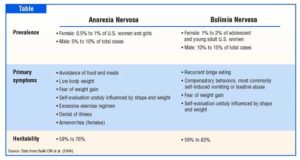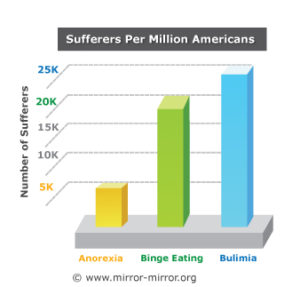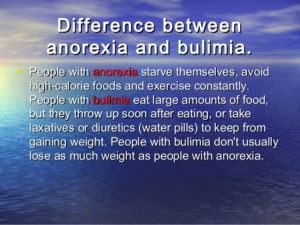Anorexia Nervosa
Anorexia Nervosa is characterized by the refusal to eat. It can affect anyone of any gender or age but disproportionately affects young women in their late teens and early twenties.
According to the most current edition of the Diagnostic and Statistical Manual of Mental Disorders (DSM-IV) there are four diagnostic criteria that must be present to achieve having Anorexia Nervosa. First a person must refuse to maintain body weight over a minimal normal weight for age and height or have a failure to make expected weight gain during a defined period of growth, resulting in a body weight 15% lower than expected. Second, the person must experience intense fear of gaining weight or becoming fat, even though underweight. Third, the person must have a disturbance in the way his or her body weight, size, or shape is experienced and also experience undue influence of body weight, or shape on self-evaluation, or denial of the seriousness of the current body weight. Finally, amenorrhea must be present. Amenorrhe is the absence of at least three consecutive menstrual cycles when otherwise expected to occur. This eating disorder affects 0.4-percent of adolescents and young women. However it is estimated that more than 4-percent of all women will struggle with anorexia nervosa over the course of their lifetime.
Bulimia Nervosa
Bulimia Nervosa is characterized by cyclical bingeing and purging episodes. Bingeing is defined as the consumption of more food than most other people would eat in a similar circumstance over a discrete period of time accompanied by a sense of lack of control over the food consumption.
Bulimia Nervosa exists when bingeing and compensatory behaviors occur on average 2 times weekly or more for a period of at least 3 months, when the behaviors are not exclusively those of Anorexia Nervosa, and when self-evaluation is unduly influenced by body shape or weight. Those with Bulimia are often very concerned about gaining weight and intensely fear getting fat.
People with Bulimia may engage in a variety of either purging or non-purging behaviors such as vomiting, using laxatives, using diuretics, using enemas, fasting, or exercising excessively. Bulimic bingeing and purging cycles are often conducted in secret because of the shame and disgust associated with the process.
Bulimia nervosa is an eating disorder affects 1.3-percent of adolescents and young women. An additional 0.7-percent of older women will develop this disorder over the course of their life.
Learn tomorrow the other eating disorders. Eating Disorders is this week’s National Awareness Topic!


